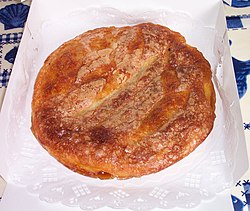 Kouign amann pastry | |
| Type | Bread |
|---|---|
| Place of origin | France |
| Region or state | Brittany |
| Main ingredients | Yeast-leavened dough, butter, sugar |
Kouign-amann (/ˌkwiːn æˈmɑːn/; Breton: [ˌkwiɲ aˈmãn]; pl. kouignoù-amann) is a sweet, round Breton laminated dough pastry, originally made with bread dough (nowadays sometimes viennoiserie dough), containing layers of butter and incorporated sugar, similar in fashion to puff pastry albeit with fewer layers. It is slowly baked until the sugar caramelizes and the butter (in fact the steam from the water in the butter) expands the dough, resulting in its layered structure. A smaller version, kouignette, is similar to a muffin-shaped, caramelized croissant.
A specialty of the town of Douarnenez in Finistère, Brittany where it originated around 1860, the pastry is attributed to Yves-René Scordia (1828–1878).[1] The name comes from the Breton language words for 'bread' (kouign) and 'butter' (amann), and in 2011 the New York Times described the kouign-amann as "the fattiest pastry in all of Europe."[2]
- ^ Gunther, Caitlin Raux (17 October 2019). "The Story of France's Most Extraordinary Pastry". Food52.com. Retrieved 2019-12-29.
- ^ Spiegel, Brendan (29 November 2011). "A Pastry From Brittany Making Waves Stateside". In Transit Blog. Retrieved 2018-10-14.